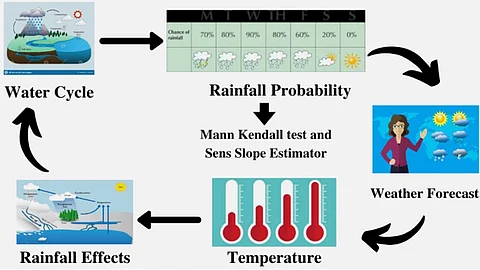

New Delhi | Researchers from the Indian Institute of Science Education and Research (IISER), Bhopal in collaboration with Australian universities and research organisations are developing statistical techniques to enhance the accuracy of rainfall predictions in Indian river basins, according to officials.
The team aims to mitigate the challenges posed by the erratic nature of rainfall, a crucial factor for India's agricultural productivity and overall sustenance, they said.
The findings of the research have been published in various journals, including--the Hydrological Sciences, the International Journal of River Basin Management and the Journal of Hydrology: Regional Studies.
"Rainfall patterns in India exhibit considerable variation in intensity, frequency, and distribution across both space and time. Accurate rainfall forecasting is of paramount importance for a nation that heavily depends on rainfall to drive agricultural operations and fuel economic progress.
"Rainfall predictions are also important to help the country tackle flooding issues and manage water resources during the erratic monsoon months of June to September," Sanjeev Kumar Jha, Assistant Professor, IISER Bhopal told PTI.
The team used Quantitative Precipitation Forecast (QPF) data obtained from a numerical weather prediction model to forecast the flow of water in rivers. By analysing a range of observational data sets, including satellite and rain gauge data, the researchers evaluated forecast accuracy across major river basins like Ganga, Narmada, Mahanadi, Tapti, and Godavari.
The team also implemented a statistical model called the Seasonally Coherent Calibration (SCC) model to enhance rainfall forecasts in the Narmada and Godavari River basins. The SCC model significantly improved the skill of forecasts over a five-day lead time. The calibrated precipitation forecasts were further applied to generate stream flow predictions using a Soil and Water Assessment Tool.
Besides Jha, the collaborative team included his research scholars Nibedita Samal, Ankit Singh, R Ashwin and Akshay Singhal; Qichun Yang and Professor QJ Wang from the University of Melbourne and Dr David Robertson from Commonwealth Scientific and Industrial Research Organisation in Australia.
"We also focused on the Ganga, Mahanadi, Godavari, Narmada, and Tapti River basins, aiming to refine Indian summer-monsoon precipitation forecasts from the NCMRWF. The team used a statistical approach called the Bayesian Joint Probability (BJP), originally used in Australia, to evaluate the approach's effectiveness in the context of India's monsoon-dominated climate.
"The study indicated that the BJP-based post-processing approach could substantially enhance forecast skills, particularly when considering only monsoonal precipitation forecasts" he said.
Jha asserted that the research carries immense potential to revolutionise India's ability to anticipate and address rainfall-related complexities.
"By applying innovative statistical methodologies to rainfall forecasts, the project promises indispensable insights for water management authorities and decision-makers, eventually fostering enhanced flood readiness and more effective water resource administration across the nation. Accurate rainfall forecasting is not just about meteorology; it's about shaping a more resilient and sustainable future for our country." "The application of statistical techniques has been demonstrated for various avalanche and glacier sites of the Himalayas, the Alaknanda River basin, and other river basins of India, such as Ganga, Narmada, and Tapi," he said.
The Water Resources and Hydrology (WRH) team is further developing a framework for impact-based forecasting to assist decision-makers in case of extreme rainfall events in urban areas by relating rainfall forecasts to socio-economic factors.
"The WRH Lab at IISER Bhopal applies advanced statistical techniques for multi-site and multivariate bias correction, temporal disaggregation, spatial downscaling, and improving the skill of medium-range rainfall forecast," Jha said.
